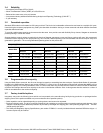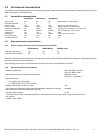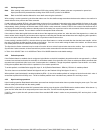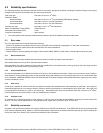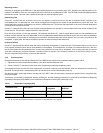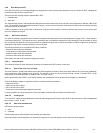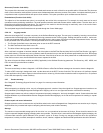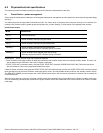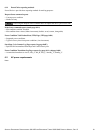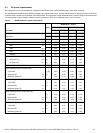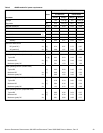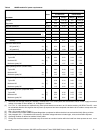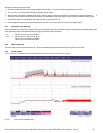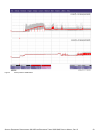SEAGATE ENTERPRISE PERFORMANCE 15K HDD AND ENTERPRISE TURBO SSHD SAS PRODUCT MANUAL, REV. B 16
Short test (Function Code: 001b)
The purpose of the short test is to provide a time-limited test that tests as much of the drive as possible within 120 seconds. The short test
does not scan the entire media surface, but does some fundamental tests and scans portions of the media. A complete read/verify scan is
not performed and only factual failures will report a fault condition. This option provides a quick confidence test of the drive.
Extended test (Function Code: 010b)
The objective of the extended test option is to empirically test critical drive components. For example, the seek tests and on-track
operations test the positioning mechanism. The read operation tests the read head element and the media surface. The write elem ent is
tested through read/write/read operations. The integrity of the media is checked through a read/verify scan of the media. Motor
functionality is tested by default as a part of these tests.
The anticipated length of the Extended test is reported through the Control Mode page.
5.2.6.2.4 Log page entries
When the drive begins DST, it creates a new entry in the Self-test Results Log page. The new entry is created by inserting a new self-test
parameter block at the beginning of the self-test results log parameter section of the log page. Existing data will be moved to make room
for the new parameter block. The drive reports 20 parameter blocks in the log page. If there are more than 20 parameter blocks, the least
recent parameter block will be deleted. The new parameter block will be initialized as follows:
1. The Function Code field is set to the same value as sent in the DST command
2. The Self-Test Results Value field is set to Fh
3. The drive will store the log page to non-volatile memory
After a self-test is complete or has been aborted, the drive updat es the Self-Test Results Value field in its Self-Test Results Log page in
non-volatile memory. The host may use Log Sense to read the results from up to the last 20 self-tests performed by the drive. The self-test
results value is a 4-bit field that reports the results of the test. If the field is set to zero, the drive passed with no errors detected by the DST.
If the field is not set to zero, the test failed for the reason reported in the field.
The drive will report the failure condition and LBA (if applicable) in the Self-test Results Log parameter. The Sense key, ASC, ASCQ, and
FRU are used to report the failure condition.
5.2.6.2.5 Abort
There are several ways to abort a diagnostic. A SCSI Bus Reset or a Bus Device Reset message can be used to abort the diagnostic.
To abort a DST executing in background mode, use the abort code in the DST Function Code field. This will cause a 01 (self-test aborted
by the application client) code to appear in the self-test result s values log. All other abort mechanisms will be reported as a 02 (self-test
routine was interrupted by a reset condition).
5.2.7 Product warranty
See “Seagate® Technology Support Services” on page
1 for warranty contact information.
Shipping
When transporting or shipping a drive, use only a Seagate-approved container. Keep the original box. Seagate approved container s are
easily identified by the Seagate Approved Package label. Shipping a drive in a non-approved container voids the drive warranty
.
Seagate repair centers may refuse receipt of components improperly packaged or obviously damaged in transit. Contact the authorized
Seagate distributor to purchase additional boxes. Seagate recommends shipping by an air-ride carrier experienced in handling co mputer
equipment.
Product repair and return information
Seagate customer service centers are the only facilities authoriz ed to service Seagate drives. Seagate does not sanction any th ird-party
repair facilities. Any unauthorized repair or tampering with the factory seal voids the warranty.
Storage
The maximum recommended storage period for the drive in a non-operational environment is 90 days. Drives should be stored in the
original unopened Seagate shipping packaging when ever possible. Once the drive is removed from the Seagate original packaging the
recommended
maximum period between drive operation cycles is 30 days. During any storage period the drive non-operational
temperature, humidity, wet bulb, atmospheric conditions, shock, vibration, magnetic and electrical field specifications should be followed.



